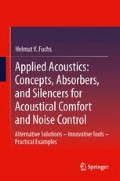Abstract
Based on the range of applications and market volume, by far the largest and most important group of sound absorbers is founded on the principle of providing sound waves upon impact, according to Fig. 3.1, as little resistance W as possible.
Access this chapter
Tax calculation will be finalised at checkout
Purchases are for personal use only
References
Babuke G, Fuchs HV, Teige K, Pfeiffer G (1998) Kompakte reflexionsarme Auskleidung für kleine Meßräume. Bauphysik 20(5):157–165
Cremer L, Müller HA (1974) Die wissenschaftlichen Grundlagen der Raumakustik, vol II. Hirzel, Stuttgart
Cremer L, Müller HA (1982) Principles and applications of room acoustics, vol II. Applied Science, London
Delany ME, Bazeley EN (1970) Acoustical properties of fibrous absorbent materials. Appl Acoust 3(2):105–116
Eckoldt D, Fuchs HV (1995) Schalldämpfer in der Ecke—ein Konzept zur wirtschaftlichen Lärmminderung in Luftkanälen. Bauphysik 17(4):115–119
Fasold W, Veres E (2003) Schallschutz + Raumakustik in der Praxis. Verlag Bauwesen, Berlin
Fasold W, Sonntag W, Winkler H (1987) Bau und Raumakustik. Verlag Bauwesen, Berlin
Frommhold W (2006) Absorptionsschalldämpfer. In: Schirmer W (ed) Technischer Lärmschutz, Chap. 9. Springer, Berlin
Fuchs HV (1995) Lärmschutz durch fortschrittliche Schalldämpfertechnologien. Z Lärmbekämpf 42(3):61–71
Fuchs HV, Möser M (2004) Schallabsorber. In: Müller G, Möser M (eds) Taschenbuch der Technischen Akustik, Chap. 9. Springer, Berlin, pp 247–304
Fuchs HV, Möser M (2013) Sound Absorbers. In: Müller G, Möser M (eds) Handbook of engineering acoustics, Chap. 8. Springer, Berlin (in press)
Fuchs HV, Zha X, Krämer M, Zhou X, Eckoldt D, Brandstätt P, Rambausek N, Hanisch R, Leistner P, Leistner M, Zimmermann S, Babuke G (2002, 2003) Schallabsorber und Schalldämpfer. Innovatorium für Maßnahmen zur Lärmbekämpfung und Raumakustik. In 6 Parts. Bauphysik 24(2):102–113; 24(4):218–227; 24(5):286–295; 24(6):361–367; 25(2):80–88; 25(5):261–270
Gödeke H, Babuke G (1999) Anwendungsorientierte Baustoffentwicklung am Beispiel eines neuen Glasschaumes. Bauphysik 21(5):236–238
Gödeke H, Fuchs HV (1998) REAPOR—sintered open-pore glass as a high-strength sound absorber. Glastech Ber Sci Technnol 71(9):282–284
Kuttruff H (1994) Raumakustik. In: Heckl M, Müller HA (eds) Taschenbuch der Technischen Akustik, Chap. 23. Springer, Berlin
Leistner M, Drotleff H (2004) Acoustical transparency of perforated panels with fabric linings. In: Proceedings—CFA/DAGA 2004, Strasbourg, pp 957–958
Lotze E (2006) Luftschallabsorption. In: Schirmer W (ed) Technischer Lärmschutz, Chap. 6. Springer, Berlin
Mechel FP (1994) Schallabsorption. In: Heckl M, Müller HA (eds) Taschenbuch der Technischen Akustik, Chap. 19. Springer, Berlin
Möser M (2007) Technische Akustik. Springer, Berlin
Tennhardt HP (1984) Messung von Nachhallzeit, Schallabsorptionsgrad und von Materialkennwerten poröser Absorber. In: Fasold W, Kraak W, Schirmer W (eds) Taschenbuch der Akustik, Sect. 4.4. Verlag Technik, Berlin
Author information
Authors and Affiliations
Corresponding author
Rights and permissions
Copyright information
© 2013 Springer-Verlag Berlin Heidelberg
About this chapter
Cite this chapter
Fuchs, H.V. (2013). Passive Absorbers. In: Applied Acoustics: Concepts, Absorbers, and Silencers for Acoustical Comfort and Noise Control. Springer, Berlin, Heidelberg. https://doi.org/10.1007/978-3-642-29367-2_4
Download citation
DOI: https://doi.org/10.1007/978-3-642-29367-2_4
Published:
Publisher Name: Springer, Berlin, Heidelberg
Print ISBN: 978-3-642-29366-5
Online ISBN: 978-3-642-29367-2
eBook Packages: EngineeringEngineering (R0)

